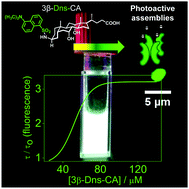Photoactive bile salts with critical micellar concentration in the micromolar range†
Abstract
The aggregation behavior of bile salts is strongly dependent on the number of hydroxyl groups. Thus, cholic acid (CA), with three hydroxyls, starts forming aggregates at 15 mM, while deoxycholic, chenodeoxycholic or ursodeoxycholic acids, with two hydroxyls, start aggregating at 5–10 mM; for lithocholic acid, with only one hydroxyl group, aggregation is observed at lower concentration (2–3 mM). Here, the singular self-assembling properties of dansyl and naproxen derivatives of CA (3β-Dns-CA and 3β-NPX-CA, respectively) have been demonstrated on the basis of their photoactive properties. Thus, the emission spectra of 3β-Dns-CA registered at increasing concentrations (25–140 μM) showed a remarkable non-linear enhancement in the emission intensity accompanied by a hypsochromic shift of the maximum and up to a three-fold increase in the singlet lifetime. The inflection point at around 50–70 μM pointed to the formation of unprecedented assemblies at such low concentrations. In the case of 3β-NPX-CA, when the NPX relative triplet lifetime was plotted against concentration, a marked increase (up to two-fold) was observed at 40–70 μM, indicating the formation of new 3β-NPX-CA assemblies at ca. 50 μM. Additional evidence supporting the formation of new 3β-Dns-CA or 3β-NPX-CA assemblies at 40–70 μM was obtained from singlet excited state quenching experiments using iodide. Moreover, to address the potential formation of hybrid assemblies, 1 : 1 mixtures of 3β-Dns-CA and 3β-NPX-CA (2–60 μM, total concentration) were subjected to steady-state fluorescence experiments, and their behavior was compared to that of the pure photoactive derivatives. A lower increase in the emission was observed for 3β-NPX-CA in the mixture, while a huge increase was experienced by 3β-Dns-CA in the same concentration range (up to 60 μM total). A partial intermolecular energy transfer from NPX to Dns, consistent with their reported singlet energies, was revealed, pointing to the formation of extremely fluorescent hybrid assemblies at 5–10 μM (total concentration). The morphology of the entities was investigated by means of confocal microscopy. At 90 μM, 3β-Dns-CA showed disperse assemblies in the μm range.


 Please wait while we load your content...
Please wait while we load your content...